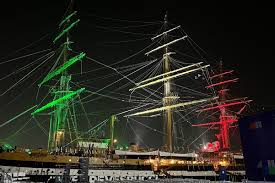 Everyone is waiting for a miracle to happen so that India can move to the next higher stage of growth, in which jobs will be created and there will be rapid poverty reduction. Everybody is waiting for a big transformation of the Indian economy when catching-up with industrial nations becomes possible. However, unfortunately in a globalised world, our actions alone are not sufficient for this.
Everyone is waiting for a miracle to happen so that India can move to the next higher stage of growth, in which jobs will be created and there will be rapid poverty reduction. Everybody is waiting for a big transformation of the Indian economy when catching-up with industrial nations becomes possible. However, unfortunately in a globalised world, our actions alone are not sufficient for this.
We are linked to the world outside through trade and investment. No wonder Prime Minister Modi has undertaken the three-nation tour recently. Apart from getting to know India’s important trade and investment partners — France, Germany and Canada, he is interested in getting in touch with the diaspora who need to be convinced that India is changing for the better. They are important potential investors.
Already, the Insurance and defence sectors have been opened up and FDI can go up to 49 per cent. Many other sectors have allowed 100 per cent foreign direct investment like railways, construction and medical devices.
Modi has promised that the many hurdles in the ‘ease of doing business’ will be removed and there will be speedy implementation of the Goods and Services tax.
It is foreign direct investment that Modi is seeking that would facilitate in realising his ‘ Make in India’ dream. India wants to occupy the space left by China in manufactured exports. But a major problem is the supply of skilled labour force.
Foreign Institutional Investors also are important for India’s stock market and for the growth of the corporate sector. A large number of FIIs have been coming to India and $ 16 billion came in 2014. Since the beginning of 2015, $5.7 billion has already come in. FII inflows have been helping the Indian stock market gain buoyancy which rose by 30 per cent in recent times. But news of US recovery and the Federal Reserve’s intention of raising interest rates have led to many FIIs leaving Indian as well as other Emerging Markets (EMs). In December 2014, the Indian stock market fell by 1107 points and again in March 2015 by 604 points, in anticipation of such a rate hike.
If there is a huge sell-off by the FIIs, the impact could be felt on the Indian rupee which would depreciate against the dollar steeply, making imports dearer. It would require intervention by the RBI to stabilise the rupee. RBI has been doing so lately. Also to stem the mass exit of FIIs, India would have to raise interest rates. This would stall Indian domestic investments further.
Even though the difference between the interest rates in the US and India is huge, a small hike of US interest rates may be attractive enough for investors because of the perception that US is a safe haven as compared to the Emerging Markets. It is enough to drive out equity and debt capital.
Among the domestic factors, high interest rates, infrastructural constraints and low demand have led to very slow industrial growth which has been declining in the last two years from 1.1 per cent in 2012-13 to (-) 0.1 per cent in 2013-14. It was 2.1 per cent between April to December 2014-15. Low manufacturing growth and low external demand has led to sluggish export growth.
India’s export growth shrank by 11.19 per cent in January 2015 and 12 per cent in February. Between April 2014 and January 2015, the cumulative export growth was only 2.44 per cent. And even when the US has been experiencing a recovery from its recessionary phase, the increase in exports to US is expected to be modest because its GDP growth rate is growing only at around 2.4 per cent. The fall in unemployment rate is also not steady and Americans are watching key indicators to improve further before they go for foreign goods in a big way.
The EU too is plunging into a downward recessionary cycle. There is no cheerful news on the Greek economic front. There is a marked possibility of Greece’s exit from the Eurozone in the future. EU has gone for quantitative easing by the European Central Bank which is buying Eurozone government bonds in the secondary market. 26.3 billion euros worth of bonds have been bought by the European Central Bank till March 2015. Injecting liquidity through the banks would lead to indirect fiscal spending and help the Eurozone countries get out of deflation or falling prices. But the low demand from EU for imports will affect Indian exports.EU has 15.7 per cent share in India’s exports.
China’s growth is also slowing down. Chinese fall in demand for raw materials may indirectly benefit India as commodity prices will fall, but it may also adversely impact demand for India’ s exports. IMF has predicted 6.8 per cent GDP growth for China in 2015 which may be on par with India’s growth this year.
The Gulf countries have become the most important trading partner of India absorbing 16.2 percent of all India’s exports. The ongoing fall in oil prices will shrink revenues and incomes of oil producers. As a result their demand for gems and jewellery exports from India will be hit.
Domestically, the economic demand scene is also far from exciting even though retail inflation reached the low of 5.1 per cent in March. But food prices are bound to rise due to the damage to crops on account of unseasonal rains and the RBI will be hesitant to cut interest rates further (it left the repo rates unchanged recently). This will be bad for the manufacturing sector as high interest rates are one of the main reasons for low investment growth in the manufacturing sector.
In March, industrial growth has fortunately picked up but some sectors remain sluggish. Capital goods’ growth however rose by 8.8 percent. With IIP growing at only 5 per cent, much needs to be done at home to achieve the dream of ‘Make in India’. If domestic manufacturing growth is slow, foreign investors will also be wary. Even though not much can be done to neutralise the adverse external situation worldwide, the NDA government can do a lot to improve the investment climate at home so that both FDI and FIIs are attracted to India in a big way.
(Courtesy of Observer Research Foundation)
Author Profile
- India Writes Network (www.indiawrites.org) is an emerging think tank and a media-publishing company focused on international affairs & the India Story. Centre for Global India Insights is the research arm of India Writes Network. To subscribe to India and the World, write to editor@indiawrites.org. A venture of TGII Media Private Limited, a leading media, publishing and consultancy company, IWN has carved a niche for balanced and exhaustive reporting and analysis of international affairs. Eminent personalities, politicians, diplomats, authors, strategy gurus and news-makers have contributed to India Writes Network, as also “India and the World,” a magazine focused on global affairs.
Latest entries
 DiplomacyOctober 4, 2025UNGA Resolution 2758 Must Not Be Distorted, One-China Principle Brooks No Challenge
DiplomacyOctober 4, 2025UNGA Resolution 2758 Must Not Be Distorted, One-China Principle Brooks No Challenge India and the WorldJuly 26, 2025MPs, diplomats laud Operation Sindoor, call for national unity to combat Pakistan-sponsored terror
India and the WorldJuly 26, 2025MPs, diplomats laud Operation Sindoor, call for national unity to combat Pakistan-sponsored terror India and the WorldJuly 25, 2025When Fire Ends, Diplomacy Begins
India and the WorldJuly 25, 2025When Fire Ends, Diplomacy Begins India and the WorldJuly 16, 2025Operation Sindoor and its Aftermath: India’s Successful Diplomatic Outreach
India and the WorldJuly 16, 2025Operation Sindoor and its Aftermath: India’s Successful Diplomatic Outreach







